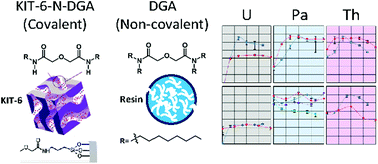Synthesis and radiometric evaluation of diglycolamide functionalized mesoporous silica for the chromatographic separation of actinides Th, Pa and U
Abstract
The separation of Th, Pa, and U is of high importance in many applications including nuclear power, nuclear waste, environmental and geochemistry, nuclear forensics and nuclear medicine. Diglycolamide (DGA)-based resins have shown the ability to separate many elements, however, these resins consist of non-covalent impregnation of the DGA molecules on the resin backbone resulting in co-elution of the extraction molecule during separation cycles, therefore limiting their long-term and repeated use. Covalently binding the DGA molecules onto silica is one way to overcome this issue. Herein, measured equilibrium distribution coefficients of normal extraction chromatographic DGA resin and a covalently bound form (KIT-6-N-DGA sorbent) are reported. Several differences are observed between the two systems, the most significant being observed for uranium, which demonstrated significantly lower sorption behavior on KIT-6-N-DGA. These results indicate that U can effectively be separated from Th and Pa using KIT-6-N-DGA, a task that could not be completed with the use of normal DGA alone.



 Please wait while we load your content...
Please wait while we load your content...
